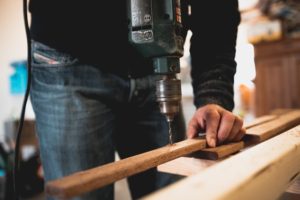Stabilizing and Bending of WOOD for the Hobbyist

Lumber scraps and cross-sections of angle cuts sawed from small logs or large limbs can be made into attractive items, but only if the wood is first treated with polymers and then properly seasoned, or if the wood is initially seasoned following special techniques. These treatments and techniques can result in profitable uses of “low grade” logs and oddly shaped scraps that might otherwise be discarded. This publication describes some techniques of stabilizing and bending wood for hobbyists.
Freshly cut cross-sections normally check badly and develop typical pie-shaped or vshaped cracks during the drying process. This is because wood shrinks twice as much in the tangential direction (parallel to the annual rings) as in the radial direction perpendicular to the annual rings). The internal stresses that result from such differential shrinkage invariably cause serious checks and splits as the wood loses moisture and comes to moisture content (MC) in a heated or air-conditioned wood shop. These are some of the techniques for drying wood cross-sections. These techniques can also be used for lumber scraps.
PEG-1000 Chemical Treatment
One method recommended often in recent years is stabilization of wood with a bulking agent such as polyethylene glycol (PEG). PEG treatment requires soaking the wood for a long time. This tends to darken the sapwood. Also, PEG is hygroscopic and raises the MC of the wood; under humid conditions, the chemical may cause the finished board surface to develop discolored streaks. To avoid these problems, you must dry the disks without chemicals.
Many hobbyists use PEG as a bulking agent that greatly reduces the dimensional changes of green wood. PEG is a white, wax-like chemical that resembles paraffin, is solid at room temperature, has an average molecular weight of 1000 and dissolves readily in warm water. PEG melts at 104 degrees Fahrenheit, is nontoxic, noncorrosive, odorless, colorless and has a very high firing point (580 degrees Fahrenheit). It is chemically related to antifreeze.
The PEG treatment, which physically bulks the wood cell walls (fibers), prevents shrinkage and thus prevents the development of destructive stresses (figure 1.). Green wood heavily treated with PEG retains its “green dimensions” indefinitely, and thus is permanently restrained from shrinking, swelling or warping, regardless of humidity changes.
To read more please visit our publication: Stabilizing and Bending of WOOD for the Hobbyist
Meet the Author
Dr. Todd Shupe is the President of Wood Science Consulting, LLC. He is a well-recognized expert on wood forensics, wood preservation, wood decay and degradation, and wood species identification. He has a broad background in new product development, quality management, and marketing and sales in both the public and private sectors. For more information please visit DrToddShupe.com.
We welcome your comments below.
Thank you for visiting. We trust that you have enjoyed reading our articles.
Liked this post? Read more below or search for more topics . . .

